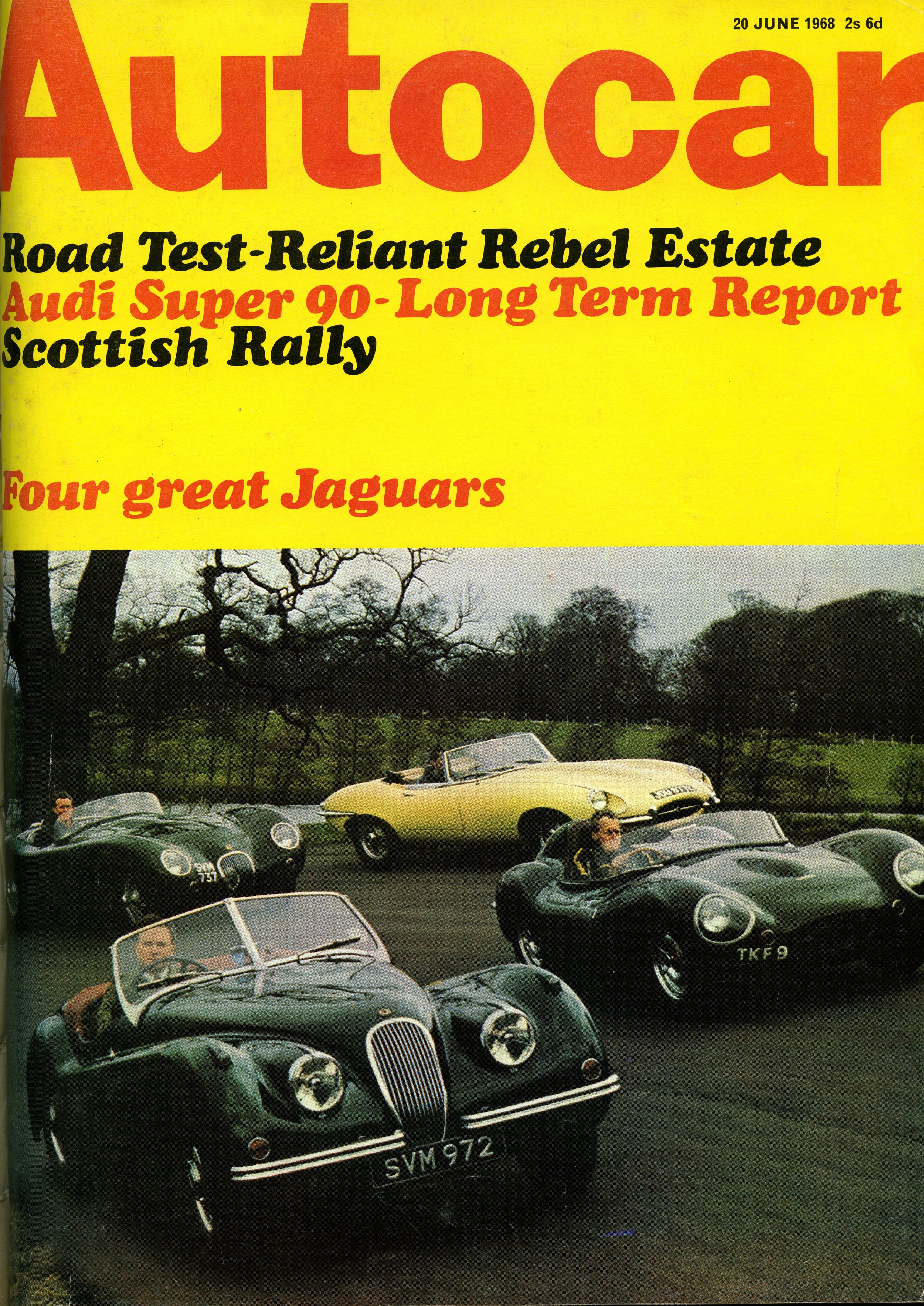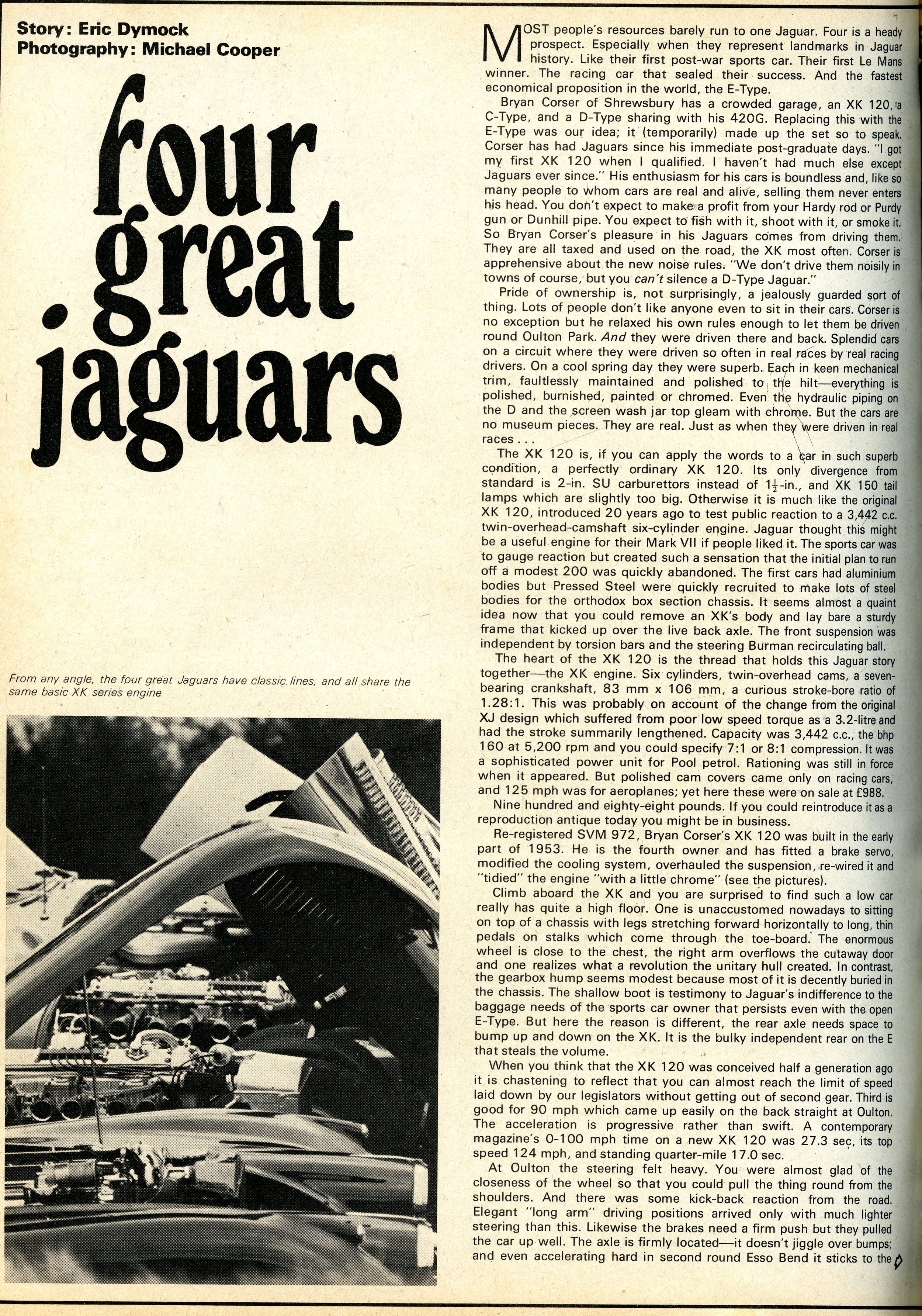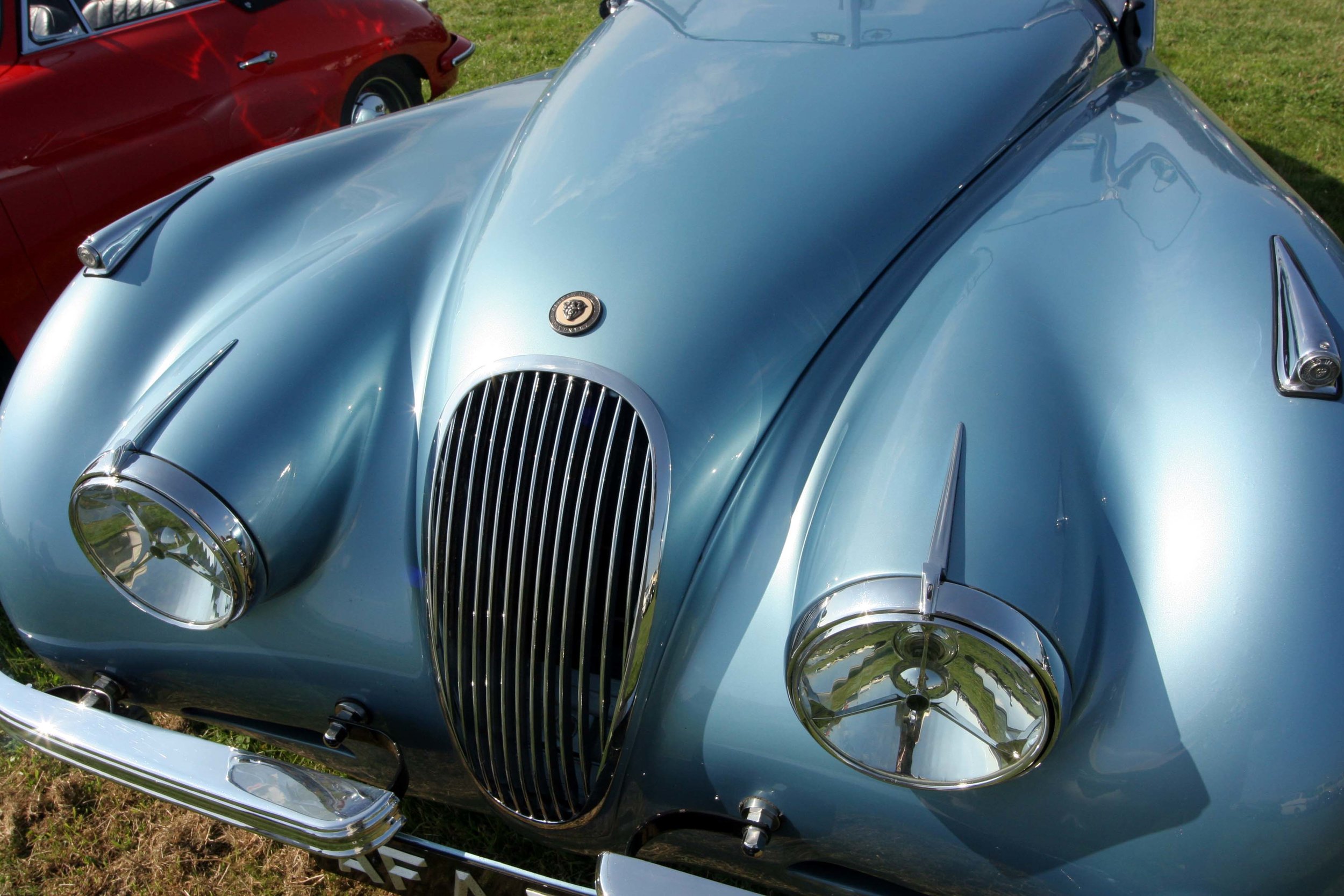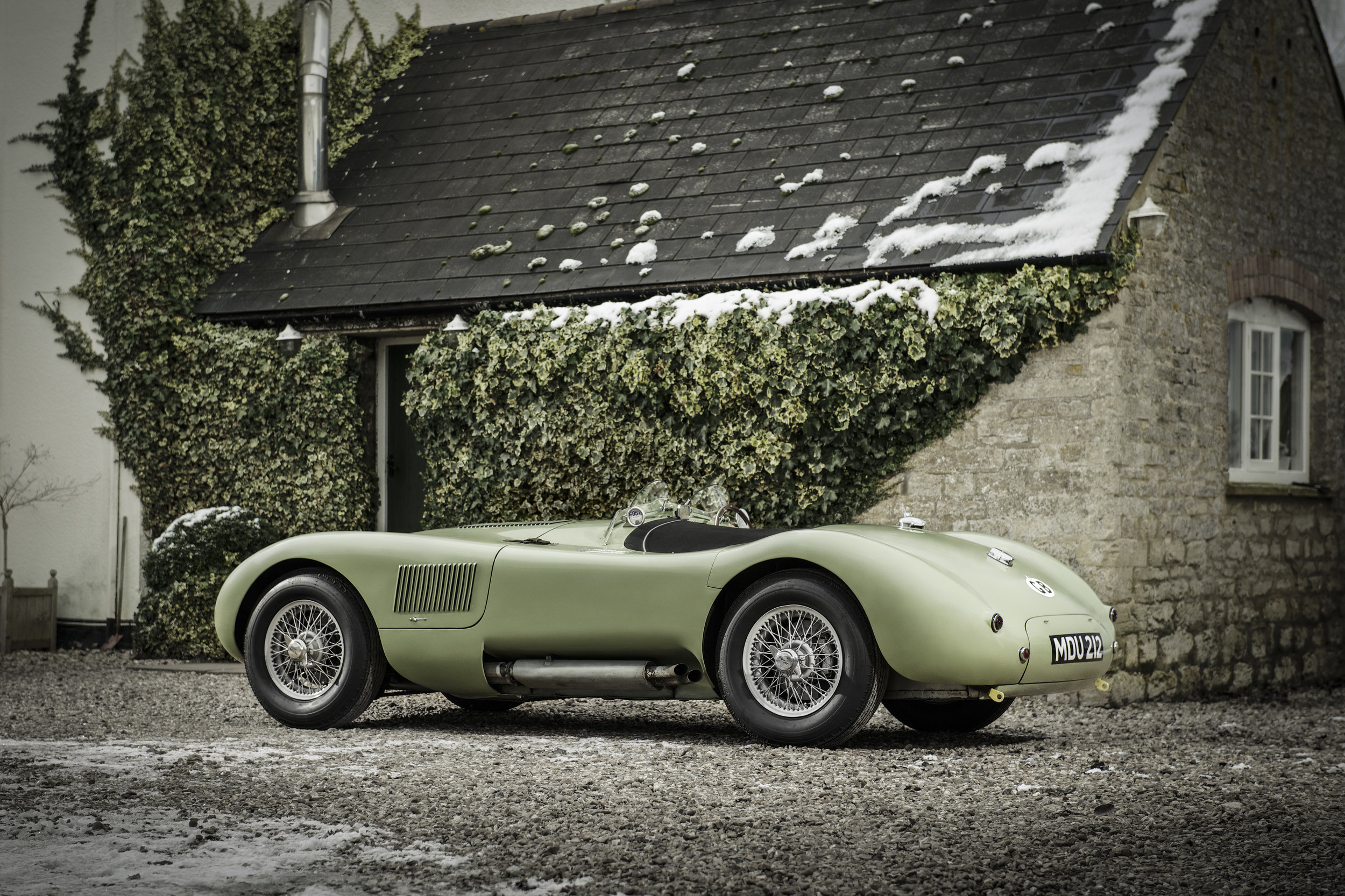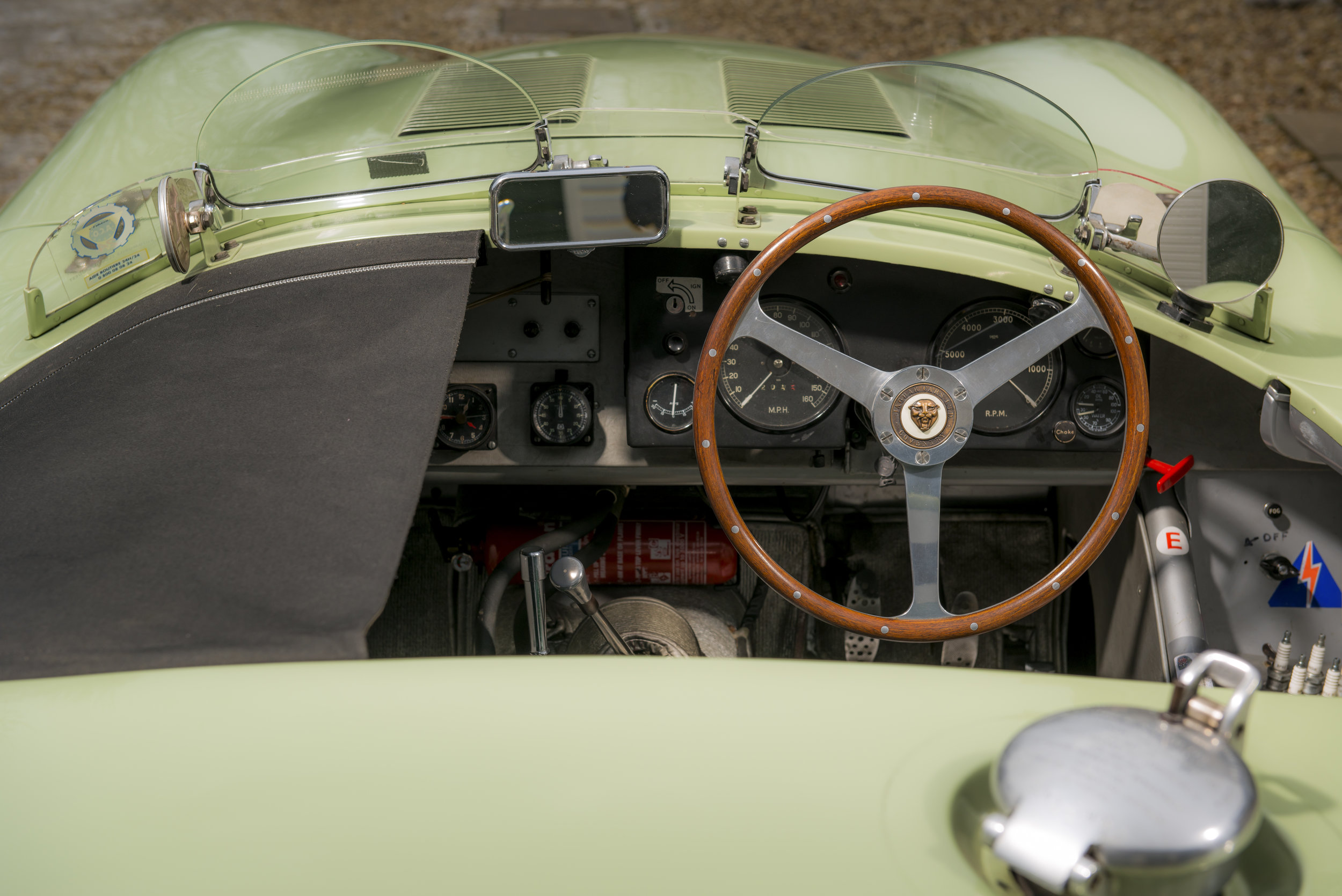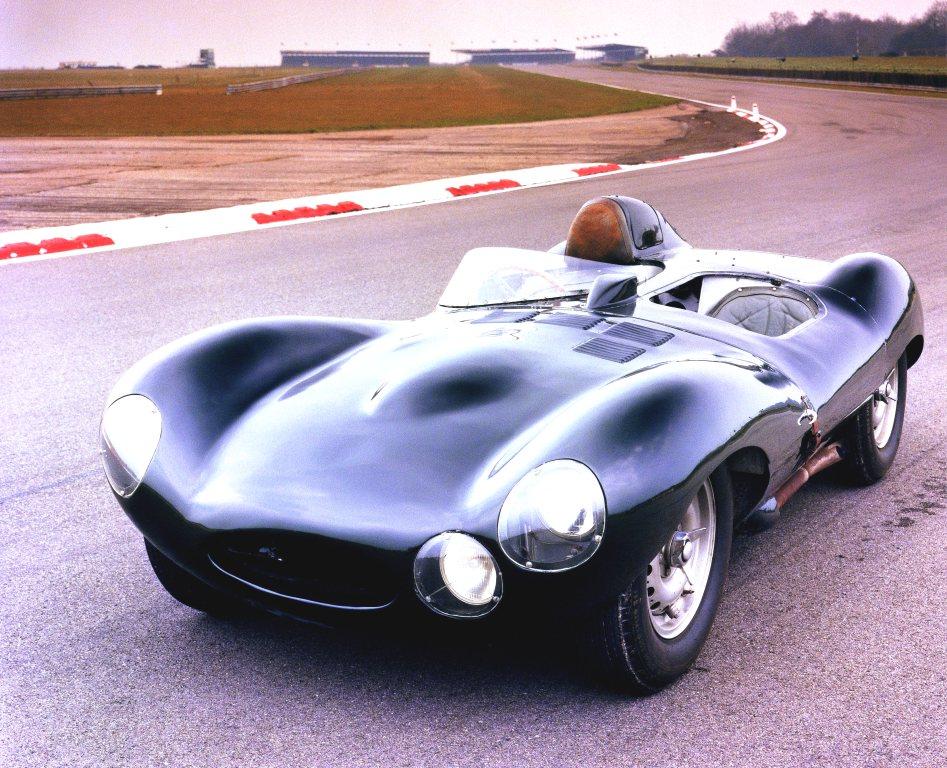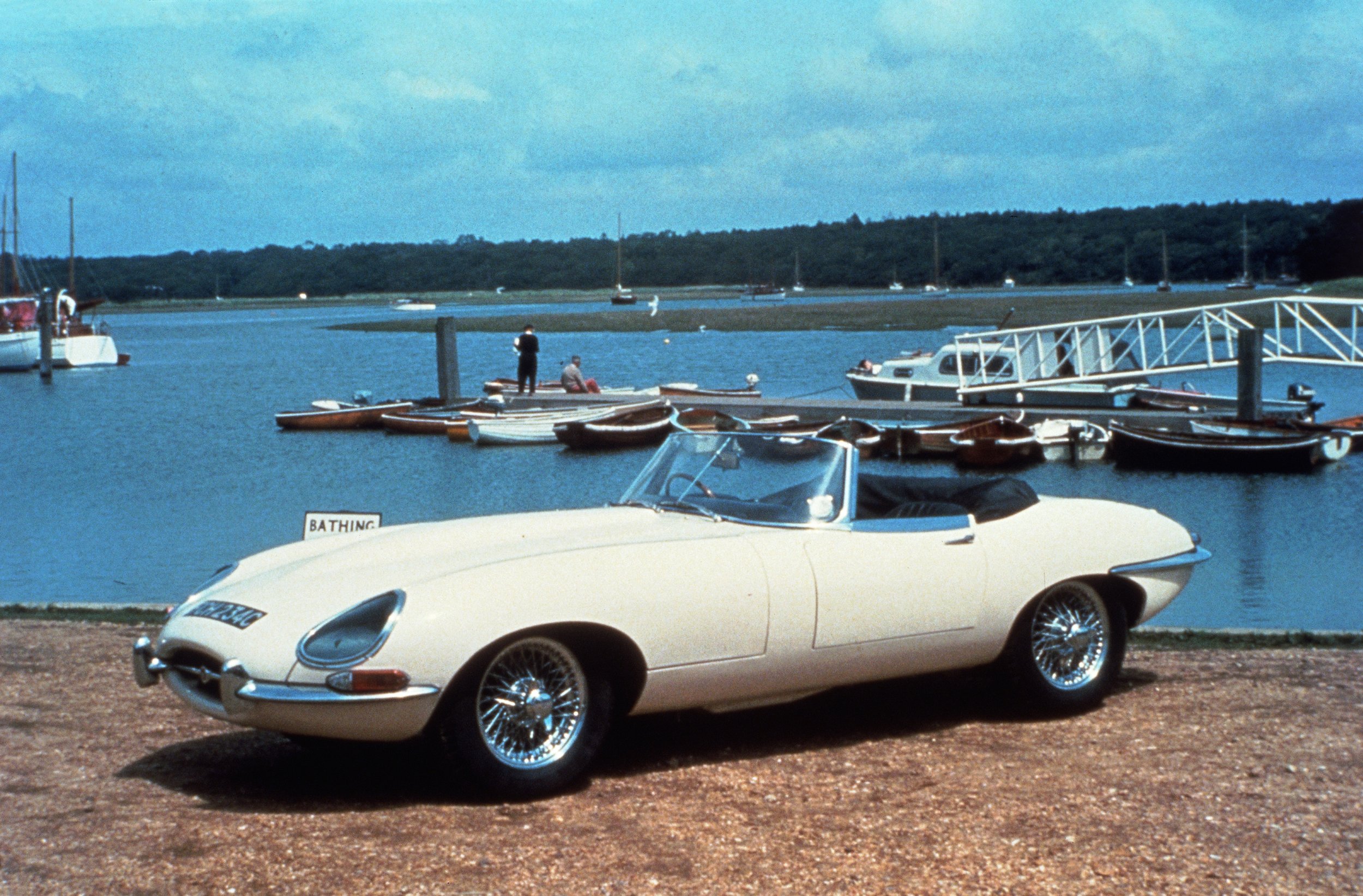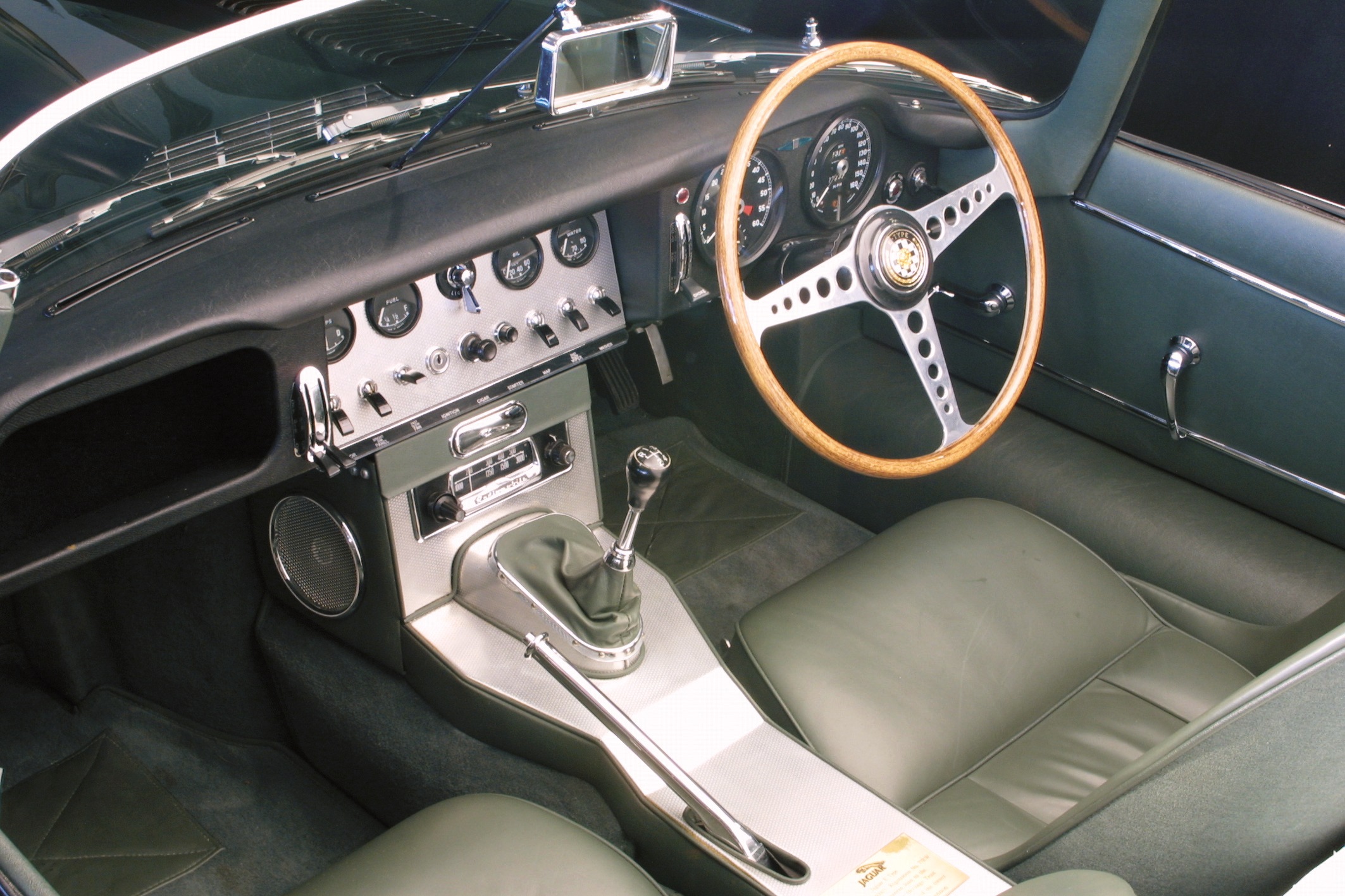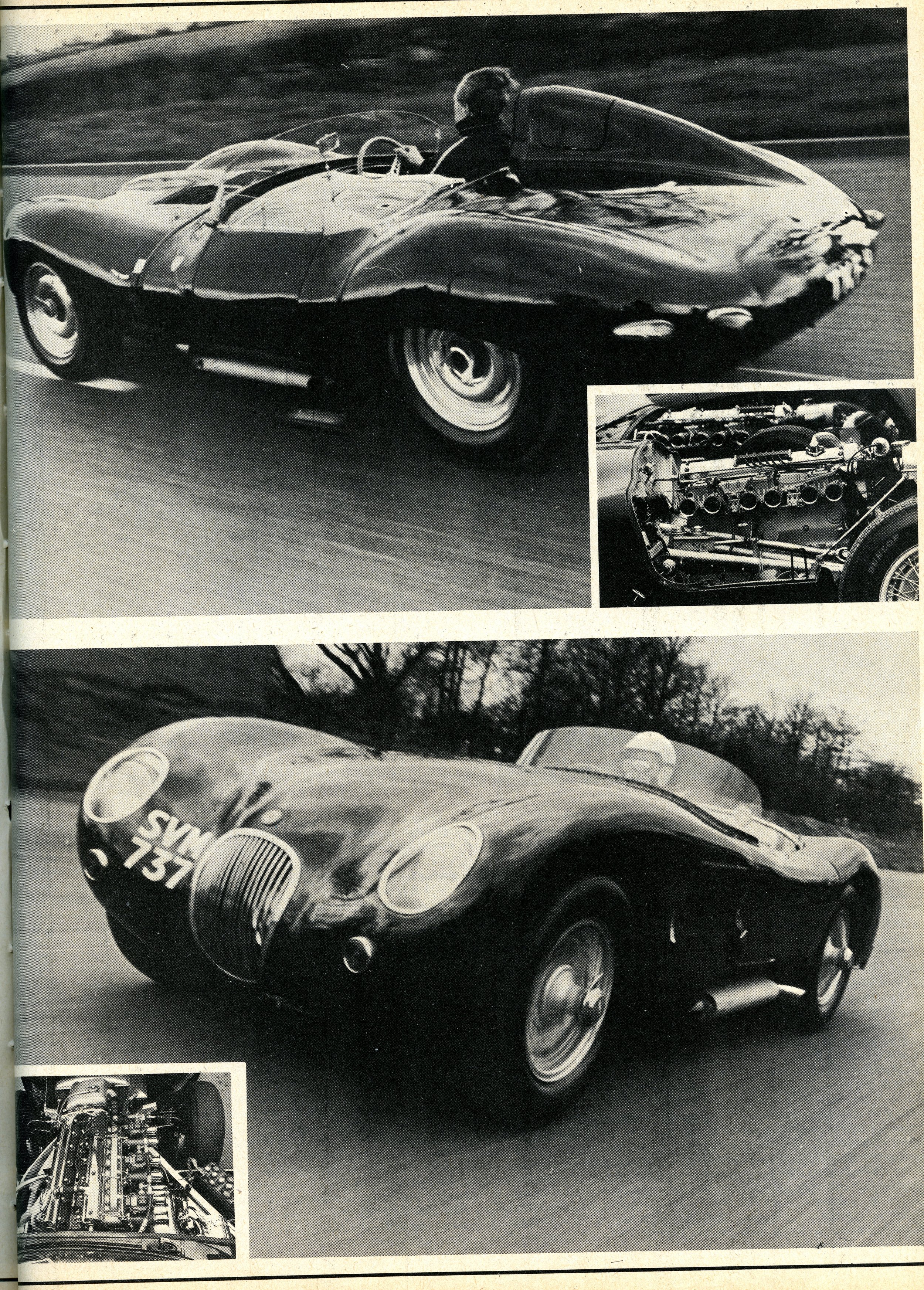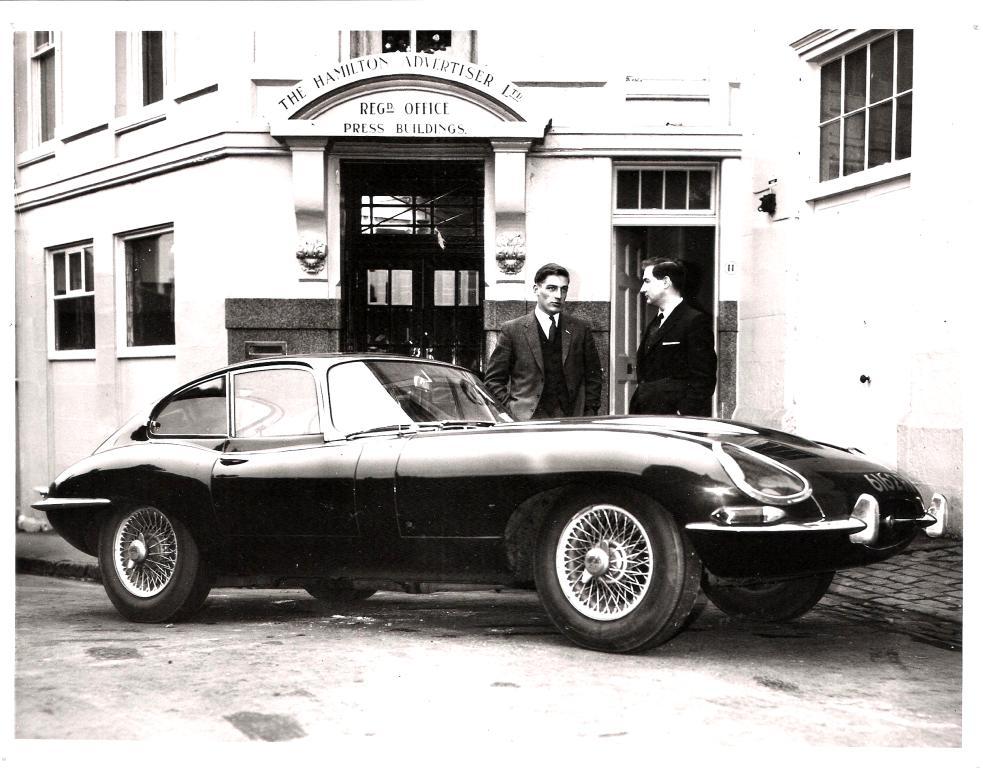Half a century ago this week. Autocar. The year Jim Clark died. Track testing at Oulton Park. Here it is again unabridged. Text Eric Dymock, photographs Michael Cooper.
Most people's resources barely run to one Jaguar. Four is a heady prospect. Especially when they represent landmarks in Jaguar history. Like their first post-war sports car. Their first Le Mans winner. The racing car that sealed their success. And the fastest economical proposition in the world, the E-Type.
Bryan Corser of Shrewsbury has a crowded garage, an XK 120, C-Type, and D-Type sharing with his 420G. Replacing this with the E-Type was our idea; it (temporarily) made up the set so to speak. Corser has had Jaguars since his immediate post-graduate days. "I got my first XK 120 when I qualified. I haven't had much else except Jaguars ever since." His enthusiasm for his cars is boundless and, like so many people to whom cars are real and alive, selling them never enters his head. You don't expect to make a profit from your Hardy rod or Purdy gun or Dunhill pipe. You expect to fish with it, shoot with it, or smoke it. So Bryan Corser's pleasure in his Jaguars comes from driving them. They are all taxed and used on the road, the XK most often. Corser is apprehensive about the new noise rules. "We don't drive them noisily in towns of course, but you can't silence a D-Type Jaguar."
Pride of ownership is, not surprisingly, a jealously guarded sort of thing. Lots of people don't like anyone even to sit in their cars. Corser is no exception but he relaxed his own rules enough to let them be driven round Oulton Park. And they were driven there and back. Splendid cars on a circuit where they were driven so often in real races by real racing drivers. On a cool spring day they were superb. Each in keen mechanical trim, faultlessly maintained and polished to the hilt—everything is polished, burnished, painted or chromed. Even the hydraulic piping on the D and the screen wash jar tops gleam with chrome. But the cars are no museum pieces. They are real. Just as when they were driven in real races... \
The XK 120 is, if you can apply the words to a car in such superb condition, a perfectly ordinary XK 120. Its only divergence from standard is 2in. SU carburettors instead of 1½in., and XK 150 tail lamps that are slightly too big. Otherwise it is much like the original XK 120, introduced 20 years ago to test public reaction to a 3,442 c.c. twin-overhead-camshaft 6-cylinder. Jaguar thought it might be a useful engine for its Mark VII if people liked it. The sports car was to gauge reaction but created such a sensation that the initial plan to run off a modest 200 was quickly abandoned. The first cars had aluminium bodies but Pressed Steel were quickly recruited to make lots of steel bodies for the orthodox box section chassis. It seems almost a quaint idea now that you could remove an XK's body and lay bare a sturdy frame that kicked up over the live back axle. The front suspension was independent by torsion bars and the steering Burman recirculating ball.
The heart of the XK 120 is the thread that holds this Jaguar story together—the XK engine. Six cylinders, twin-overhead cams, a seven bearing crankshaft, 83.mm x 106 mm, a curious stroke-bore ratio of 1.28:1. This was probably on account of the change from the original XJ design which suffered from poor low speed torque as a 3.2-litre and had the stroke summarily lengthened. Capacity was 3,442 cc, the bhp 160 at 5,200 rpm and you could specify 7:1 or 8:1 compression. It was a sophisticated power unit for Pool petrol. Rationing was still in force when it appeared. But polished cam covers came only on racing cars, and 125 mph was for aeroplanes; yet here these were on sale at £988.
Nine hundred and eighty-eight pounds. If you could reintroduce it as a reproduction antique today you might be in business.
Re-registered SVM 972, Bryan Corser's XK 120 was built in the early part of 1953. He is the fourth owner and has fitted a brake servo, modified the cooling system, overhauled the suspension, re-wired it and "tidied" the engine "with a little chrome" (see the pictures).
Climb aboard the XK and you are surprised to find such a low car really has quite a high floor. One is unaccustomed nowadays to sitting on top of a chassis with legs stretching forward horizontally to long, thin pedals on stalks, which come through the toe-board. The enormous wheel is close to the chest, the right arm overflows the cutaway door and one realizes what a revolution the unitary hull created. In contrast, the gearbox hump seems modest because most of it is decently buried in the chassis. The shallow boot is testimony to Jaguar's indifference to the baggage needs of the sports car owner that persists even with the open E-Type. But here the reason is different, the rear axle needs space to bump up and down on the XK. It is the bulky independent rear on the E that steals the volume.
When you think that the XK 120 was conceived half a generation ago it is chastening to reflect that you can almost reach the limit of speed laid down by our legislators without getting out of second gear. Third is good for 90 mph which came up easily on the back straight at Oulton. The acceleration is progressive rather than swift. A contemporary magazine's 0-100 mph time on a new XK 120 was 27.3 sec, its top speed 124 mph, and standing quarter-mile 17.0 sec.
Jaguar publicity pictures of C-type, production short-nosed D-type like TKF9.(no tail fin) and 1965 E-type press car like the 1967-reg one I drove at Oulton.
At Oulton the steering felt heavy. You were almost glad of the closeness of the wheel so that you could pull the thing round from the shoulders. And there was some kick-back reaction from the road. Elegant "long arm" driving positions arrived only with much lighter steering than this. Likewise the brakes need a firm push but they pulled the car up well. The axle is firmly located—it doesn't jiggle over bumps; and even accelerating hard in second round Esso Bend it sticks to the ground without spinning the inside wheel. There is little body roll, perhaps emphasized by the (for a sports car) comparatively high driving position. With the basic understeer, you can poke the back of the XK round with the throttle, although it is not the sensitive modern sort of car you can set sliding and “catch” when you want to. The borderline between keeping on the rails and a sharp, rapid breakaway was a little close. The ride is firm but fairly level; there is very little pitching and the structure feels stiff with hardly a suggestion of scuttle shake.
Mercifully, the old gearbox has been abandoned. Drive an XK and you wonder how it survived for so long. You need the old Jaguar “pause-one-two” between changes to prevent clashing the gears. Not because the mechanism was worn but because the constant-load synchromesh was never very strong anyway. The clutch helps compensate with a light, short travel. Drum brakes may have been a reputed weakness of the car but the addition of a servo seems to have helped matters and they stood up well to some fairly brisk work at Oulton. They smelt a bit but the linings had recently been renewed.
Start up the XK 120 and there is no mistaking what it is. The characteristic "thrum" must have helped create the Jaguar mystique. It is not high-revving and in XK 120 form the power won't jerk your head back; but it does produce its energy all the way up the range.
The XK 120 was a classic car. Elegant and gentlemanly, the flowing lines were spoiled with the XK 140. The 150 restored some of the panache but the crisp silhouette had gone. It was well mannered and docile and quite, quite unlike the car that really established the Jaguar as a racing marque, the XK 120C.
Bryan Corser's C-Type was the last production model to leave the factory. It has chassis number XKC 050 and (like the 120) was completed in 1953, to be followed only by the 1953 Le Mans cars. With 220 bhp and those historic disc brakes, Rolt and Hamilton won raising the race record by 9 mph and making the first ever 100 mph race average. Moss and Walker were second, Whitehead and Jimmy Stewart (Jackie's brother) fourth behind a Cunningham.
Encouraged by the performance of the XK 120, Jaguar laid down the first C-Types in 1950. The engine and transmission had been proved at Le Mans the same year in XK 120s but clearly a lighter, better handling car was needed. Bigger carburettors and better breathing brought the power up to over 200 bhp with basically the same XK engine, installed in a tubular frame—a light, stiff complex of steel tubing triangulated on a basis of channel-section members. The entire scuttle section was welded-up in one piece, and the rear suspension was a highly original arrangement using a plain live axle. The frame effectively stopped at a point just behind the seats and the axle was hung on behind by trailing links from each end of a single transverse torsion bar anchored at the centre. An A-bracket above the axle located it laterally and also took care of torque reaction, the object being to produce a sort of simplified de Dion arrangement. The steering was changed to rack-and-pinion and the new body shape reduced the power required to reach 100 mph by 20 per cent. The top speed of the 1951 Le Mans cars was around 150 mph, and a C-type won the race on its first public appearance.
The Corser C-Type was formerly owned by Paul Emery, John Broad, and originally Joe Kelly. It now has a 3.8-litre engine with three 45 DCOE Webers; but apart from that has been painstakingly restored to original condition.
The first obvious difference from the XK is that you sit in the C-Type rather than on it. There is bare tubing and less room in the cockpit, but plenty to brace your leg against on corners and the facia is engine-turned, not leather trimmed. You are low down in a high-speed bucket of a car, and when you fire it up you feel it demands a little bravura. The engine coughs, and then barks a crisp warning not to take liberties on the circuit.
Through the gears it is much fiercer than the 120. Without touching the red sector of the tachometer you can reach well over 70 in second, and 110 in third—by which time you are running out of Park at Oulton and getting buffeted by the slipstream over the low screen. The ride is hard, and going round corners is a serious business. Choose the line and open the throttle just the right amount and stick to it. A change of course or a faint-hearted lift-off in the middle of a bend can produce a good deal of drama. The power comes in with a bang at 3,000 rpm but, perhaps unrepresentatively with this particular engine, goes straight out again around 5,000. It then became rather flat but not so much as to dull the exhilaration of mastering this animal of a car. The drum brakes snatched and pulled until they were thoroughly warm. Once they reached working temperature they were powerful and progressive. The gearchange remained slow and the ratios wider than you would maybe want on most circuits.
You become oddly sensitive to smells driving these cars on a track. A whiff of hot oil on the straights, pungent rubber dust, the acrid scent of hot brakes coming up to corners all remind you that these are racing cars. And all the time that hard blare of noise from the exhaust. The adrenalin runs freely. Especially if you have to change your mind half way through Druids.
No car is more clearly a racer than the D-Type—three times a Le Mans winner. It must be one of the most dramatic-looking cars ever made. Yet it is as polite as a Mini Minor. Compared with the C it is a ballet dancer. And today, 13 years after it left Browns Lane, it is still one of the fastest production cars ever manufactured. A good D is such a collector's item that when one does come on the market, upwards of £5,000 is likely to change hands.
Corser is the seventh owner of TKF 9. It is the only one of his cars to retain the original registration number, which he keeps for its historical associations. It was originally sold by Henly's of Manchester to Gillie Tyrer, then to Alex McMillan, Murkett Brothers when it was raced (and crashed more than once) by Henry Taylor. The Border Reivers bought it for the late Jim Clark, then a "promising young driver" who told wonderful tales of driving it on the road when the Reivers' transporter broke down; and of travelling fast on a dual carriageway in Norfolk and passing another D-Type going in the opposite direction at a closing speed of about 250 mph. Clark cut his racing teeth in TKF 9, and in 1958 at Full Sutton averaged over 100 mph, making this the fastest sports car race run in Britain up till that time. Allan Ensoll then tried to convert it into an XKSS, subsequently selling it in Ireland where Corser found it in rather a sorry state. He refitted the headrest, which had been removed, reconditioned the gearbox and changed the axle ratio to a more reasonable 3.33:1. The brakes reverted to their original assisted twin system and the engine was overhauled. This work took two years.
The 1955 D-Type had the magnesium central section, but the front tubular sub-frame was not integral and made from steel, not aluminium. The engine is dry-sump with no proper flywheel. It makes do with a crankshaft damper and the mass of a triple-plate clutch. With 285 bhp on three Webers, a 2.79:1 axle, and 6,000 rpm (only 250 rpm above peak power) it would do 183 mph.
A 1955 production D, TKF 9 has a short nose and a head fairing but no fin. "It would look nice but it wouldn't be genuine."
When you climb in through the tiny, fragile door it is like the confines of a space capsule, close fitting, fully instrumented, and functional. The leather is soft and the seat hugs you—the view over the front is like a bulgy E-type. Superficially, the D does feel like an E in many ways. The smooth ride, the easy way you can power out of corners and keep a firm grip of the road; the rear suspension is hung on the back much like the C's but with different trailing arms. Everything is more direct than in an E—you can really "fly" this one with the seat of your pants. The steering is sensitive, cornering progressive and predictable. With the good manners of Dunlop racing tyres and the splendid balance of the D you can break it away at the front or the back or on all four wheels at once if you want to. It is a car that does as you tell it to, no more, no less.
Gear ratios are close and the change, quite un-Jaguar-like for 1955, is superb. The brakes are like pressing a small, hard rock but how well they work, again and again without fading. An impeccably handling car, exciting, perhaps less well suited to tight slow corners than long fast ones, and a car for a fast circuit, but most satisfying to drive.
After that, the E-Type did feel just a little soggy, but a comparison would not really be fair. It was a road E and when you got it back on the road it was easier to see where the good points of the D had rubbed off. The stiff hull, the smooth ride, even the way you can apply the power and get a grip of the road in wet or dry weather is clearly a legacy of the great racing Jaguars.
Below: E-type interior of 1960s. Michael Cooper's Autocar photographs. On right One of the first E-types I ever drove; Glasgow Motor Show demonstrator 1961 by office of my first motoring column, Hamilton Advertiser. On left Jaguar apprentice Clive Martin. Featured in The Jaguar File.
